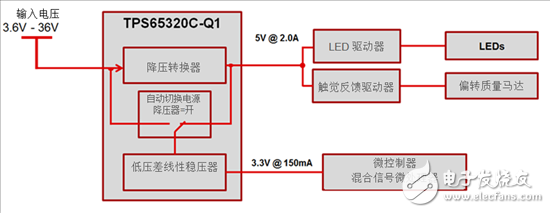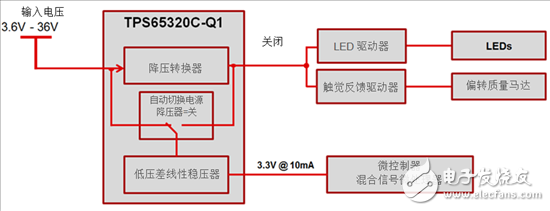In recent years, automotive electronic devices have become increasingly important in the design of automotive systems. You may also often hear about the increasing convenience features of cars, the advancement of more advanced infotainment, driver assistance systems and driverless vehicles. To drive innovation in automotive systems, the size of each new device must be optimized to meet increasingly demanding design requirements. But what does this mean for a tree power tree that powers a variety of devices?
In the first and second part of this article, I will explore how innovation can change the automotive electronics market and how TI can help solve a ubiquitous design problem in this area by integrating buck converters and LDOs.
Most electronic control units (ECUs) must be equipped with at least two adjustment rails to efficiently power the various components of the system. Although two tracks are required, the current requirements of the two tracks vary greatly.
Take the LED ceiling light with tactile feedback as an example. The device's power supply system requires a 5V track to simultaneously power the LED driver and the haptic driver that controls the deflection mass motor (ERM). Both LED and haptic drivers are current-intensive devices with a current requirement of approximately 2A. The use of a buck converter is the best choice for providing this type of current because it enables efficient current conversion to ensure that the system does not experience heat under this load. The core component of the automotive ECU is a microcontroller (MCU) with a voltage of 3.3V but a current demand of only 150mA. When the car is turned off, although the MCU can switch to the standby power saving mode, it cannot be completely turned off because the communication and wake-up functions are also processed.
For these applications, you have the option of using a low dropout regulator (LDO). As the most cost-effective electronic component, the LDO provides both a weak current and a clean power rail for microprocessors that are susceptible to noise nuisance. However, in standby mode, the LDO will be directly connected to the car battery, which will cause a large voltage drop. Since LDOs are not the most efficient solution for powering microcontrollers, can you suggest some optimizations for total power consumption?
With the TPS65320C-Q1 , you can power your system directly from the battery. The product supports input voltages from 3.6V to 36V and has two output rails: a 3.2A buck converter that converts frequencies from 100kHz to 2.5kHz with 10% conversion accuracy. The other is a 289mA LDO. The two tracks are integrated into a small 14-pin thin small outline package (HTSSOP).
Take the LED ceiling light in the car as an example. You can use a buck converter to power a 5V track. The LDO uses a 3.3V track, as shown in Figure 1. Integrating the two tracks into a small chip not only saves space, but also adds a function that increases the system's power efficiency: LDO automatic power supply. When the buck converter starts operating, the switching regulator will switch the output to the LDO's power supply, which minimizes voltage drop, power loss, and heat dissipation.

Figure 1: Working module diagram of the car ceiling light in working condition
When the buck converter is inactive, the LDO will remain active and automatically switch to battery voltage so that the MCU will remain operational while the rest of the system is shut down. The principle is to obtain a typical quiescent current of less than 35μA from the LDO, as shown in Figure 2:

Figure 2: Working module diagram of the ceiling light in the car in standby mode
You can see similar use cases on almost all in-vehicle devices, including infotainment, advanced driver assistance systems (ADAS), dashboards and body electronics.
Do you have the exact opposite requirement: 100mA is required on a 5V rail, but 2A is required on a 3.3V rail? Stay tuned for the next part of this article, where I will discuss how the wide VIN integrated buck converter and LDO can power your car system.
For any questions about LED ceiling light design or other design, please log in and leave a comment below.
other information
The replacement bulb lamp is a substitute bulb for the projector. The price of the replacement bulb lamp will be more affordable than the original Projector Lamp, and the average life can reach 3000 hours, which is suitable for basic film and television in daily life. The operation is simple and easy to install.
Replacement Bulb Lamp,Projector Bulb,Replacement Original Bulb Lamp,Projector Bulb Lamp
Shenzhen Happybate Trading Co.,LTD , https://www.happybateprojector.com